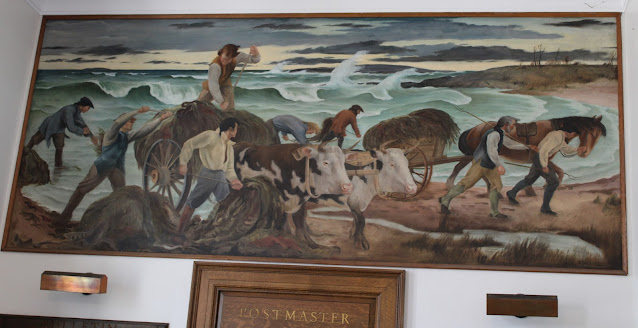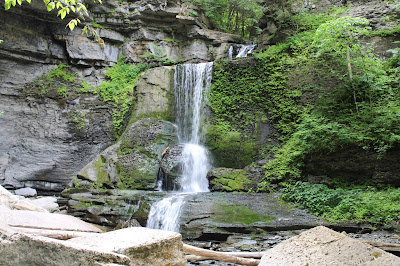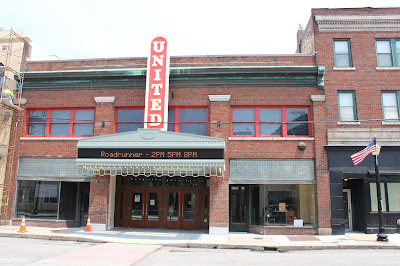Located just north of the Georgia-Florida border,
Cumberland Island National Seashore is a 17-mile-long barrier island. Although
various people and cultures have made the island home, today access is highly
regulated to protect its fragile ecosystems. No more than 300 visitors are
allowed on the island at a time and the only way to visit is by boat. The
number of vehicles is low and the lone hotel, which is extremely exclusive, is
a holdover from decades past.
The National Park Service runs a 30-minute ferry to and
from Cumberland Island. Spaces on the boat, which also ferries bikes and
camping equipment for visitors, are limited and reservations are a necessity
during peak times. Even in mid-May, before schools were out, the boat was quite
full. An interesting assortment of people on the boat, in varying degrees of
preparedness, were on our outward journey. A couple from the Air Force,
coincidentally he was from the Louisville area as well, were taking the ferry
for a four-day backpacking trip on the island to explore the northern half and
enjoy some beach time. Their trip contrasted with two young women in short bright
yellow jumper and sandals looking like she was out for an evening at the beach
bars, seemingly unprepared for the sun, lack of services, and heat while on the
island. I overheard her say that she was “really hungover,” which usually means
dehydration. I thought to myself her day might not go well, although I could be
wrong. I was a little surprised by the number of people who took the ferry
across, unload equipment and carted it across the approximately one-mile width
of the island to spend a day at the beach; admittedly the seashore is quite
secluded, beautiful, and not at all busy.
Arriving shortly before 10am and having six hours to wander
and explore, to see animals, and observe humans is a real luxury – the luxury
of time. The only deadline is the departure time for the return ferry.
The St. Marys River is the dividing border between
Florida and Georgia. From the ferry, in the distance, a paper mill plant in the
town of Fernandina Beach Florida, on Amelia Island, is visible. Built in the 1937,
a time before roads and tourism were prevalent in the area, the plant processes
trees, and like other paper mills can produce a foul odor that I equate with
rotten eggs and/or sulfur. While
many complain about the pollution and the smell, the company retorts that it
contributes to local wages and taxes. It is the arguments between economic prosperity
and environmental protection. When pitched in the dichotomous frame of either/or,
it appears to be an intractable problem that it is not.

Why do most people come to Cumberland Island? Is it
history or wildlife? The preserved natural beauty, the birds and wildlife, as well
as pristine beaches are certainly a draw. I find my curiosity vacillating
between history and nature while thinking about island and time spent there. To
focus on the Cumberland Island’s human history, fascinating though it may be,
is to do it a disservice. It is a beauty island, with nature repairing itself
after decades of agriculture and invasive species. Three distinct terrains dominated
on any preserved barrier island: the maritime forests, salt marshes, and sand
dunes, each of which are easily accessible from the ferry dock.
 |
| Our picnic spot for lunch |
As we wandered along the designated paths on the southern
part of the island, it was fun to see many animals, including a raccoon,
salamanders, armadillos, a few glimpses of deer, and, of course, the wild
horses, that freely wander the island. Birdwatching, too, was fun. The mixture
of ecosystems means that there is a wide variety. Eating lunch beneath the
twisted limbs of the live oaks, we watched in astonishment northern parulas
feeding their young. Breezes bring salt air that stunts the growth of the
trees, creating a complex puzzle of twisted branches as they seek more sun. The
trees create shade and relief from the punishing sun and heat. Although their
breeding area covers Pennsylvania, I have never seen a northern parula in the
state. With a diet consisting of insects, they are particularly fond of Spanish
moss during the breeding season, which is plentiful on the Island.
 |
| Northern Parula chick waiting to be fed |
Despite an abundance do wildlife, most of the signage on
the island points the visitor’s attention to the legacy of the Carnegie family.
In some ways this is a clever dodge, to divert people from concentrating on the
years of slavery, plantations, and the treatment of those who were not
powerful. However, a small sign at the dock, often missed because it is not in the
direct line of sight when one leaves the ferry, explains to the visitor that
human occupation of the island has occurred for several centuries, and this
place was once called Tacatacuru. But the sparse amount of information about
the Timucuan people reveals had little is known or understood about the culture
and the lives of the people. Europeans began to arrive in the area during the
sixteenth century, and most of our knowledge about the Timucuans, their
language and culture is filtered through those European eyes. The large Spanish
Mission of San Pedro de Mocama, which introduced Roman Catholicism to the local
population, was part of the imperial contest for land, wealth, and influence in
North America. Its exact location remains undiscovered, but its existence dominated
political relationships and was a symbol of ownership in Spain’s struggles with
the French and British colonial interests.
While this nod to indigenous history raises interesting
points, it is the histories of the nineteenth and twentieth centuries that demands
most of the park’s attention. The backdrop of slavery and the American Civil
War plays a part in the island’s history, especially since Robert E. Lee’s
father was interred on the island for a time. But it is the post-war
industrialization of the country, and the rise of rich industrialists that figure
prominently. Thomas M. Carnegie, brother of famed philanthropist Andrew, began
building a 59-room mansion called Dungeness in 1884. Its dock is the one used
by the National Park Service to ferry passengers from St. Marys each day.
Thomas died just two years later in Pittsburgh, never seeing his vacation home
completed. His wife Lucy, along with nine children, would finish the project as
well as several others on the island. In the years that follow, she oversaw the
construction of other estates for her children, including Greyfield, Stafford
Plantation, and Plum Orchard. The story of the Carnegie family is fascinating
and reaches into the core of many American towns with the libraries built by
Andrew Carnegie’s fortune. It made his name familiar, and his legacy remains
relevant as the architecturally appealing libraries demand protection and
restoration more than a century later.
 |
| Dungeness today |
After Lucy’s death in 1916, Dungeness largely remain
unoccupied. Her daughter Nancy’s wedding was held there in 1929 as the last
major event in the mansion’s history. It was destroyed by fire in 1959. While
the ruins are off limits to the visitor, it is fun to peer inside and have a
look at faded glory. As I circumnavigated the nineteenth century mansion, a
monument to industrialization and grad wealth, it struck me we rarely think
about our homes in the future, after we are gone. In all probability my home
will exist after I am gone, but what is its fate? Who will live there? How will
it come to an end? I watched the wild horses graze in the front lawn by a
fountain that has not worked in an exceptionally long time as I thought about
it. I imagine they are saying to themselves, “yet another human taking photos
of ruins that we see every day.” I know
they do not, but why do we feel compelled to photograph, consider, and ponder
the ruins of such a mansion? One cannot help but think about
Citizen Kane,
surrounded by all his physical treasures in his old age, many of which will end
up in the incinerator.
 |
| Wild horses roam the grand front yard of Dungeness |
The now abandoned settlement of High Point, an abandoned
black community on the north end of the island, is likewise compelling. Founded
in the late nineteenth century, the community consisted of former enslaved people
and their descendants. The focal point of the site, which is under the auspices
of the National Park Service, is the First African Baptist Church built from
salvage lumber in 1937. Located fifteen miles north of the ferry dock, the
community is difficult to access, especially so for day trippers to the island.
One of the estates where blacks on Cumberland Island
would have worked as servants and caretakers was Plum Orchard, the home of George
Lauder Carnegie. He was the son of Thomas and nephew of Andrew Carnegie. George
married Margaret Copley Thaw, who was widowed in the early 1920s. Margaret left
Cumberland Island, traveled, and spent time in New York City after George’s
death. Two years after her husband’s death she married the Count de Périgny and
became a Countess; however, the following year she was sued by Madeline Modica
for alienation of affections. Her husband, a car salesman, had developed a
friendship with Margaret. But the New York newspapers were skeptical that she
would have had a romantic relationship with Emmanuel Victor Modica describing
him as “dark, has large eyes and is of slender build,” presumably suggesting
that an affair with the countess would be shocking. In
the race conscious 1920s, recent Italian immigrants were not considered
acceptable marriage or companion materials for society women. Shortly after the
scandal, Margaret and her new husband left the United States and settled on his
farm in colonial Kenya where she died in 1942.
 |
Wilson's Plover
|
 |
| Royal Tern |
 |
| Northern Parula |
 |
| A brown-headed Cowbird catching a ride on a wild horse |




























